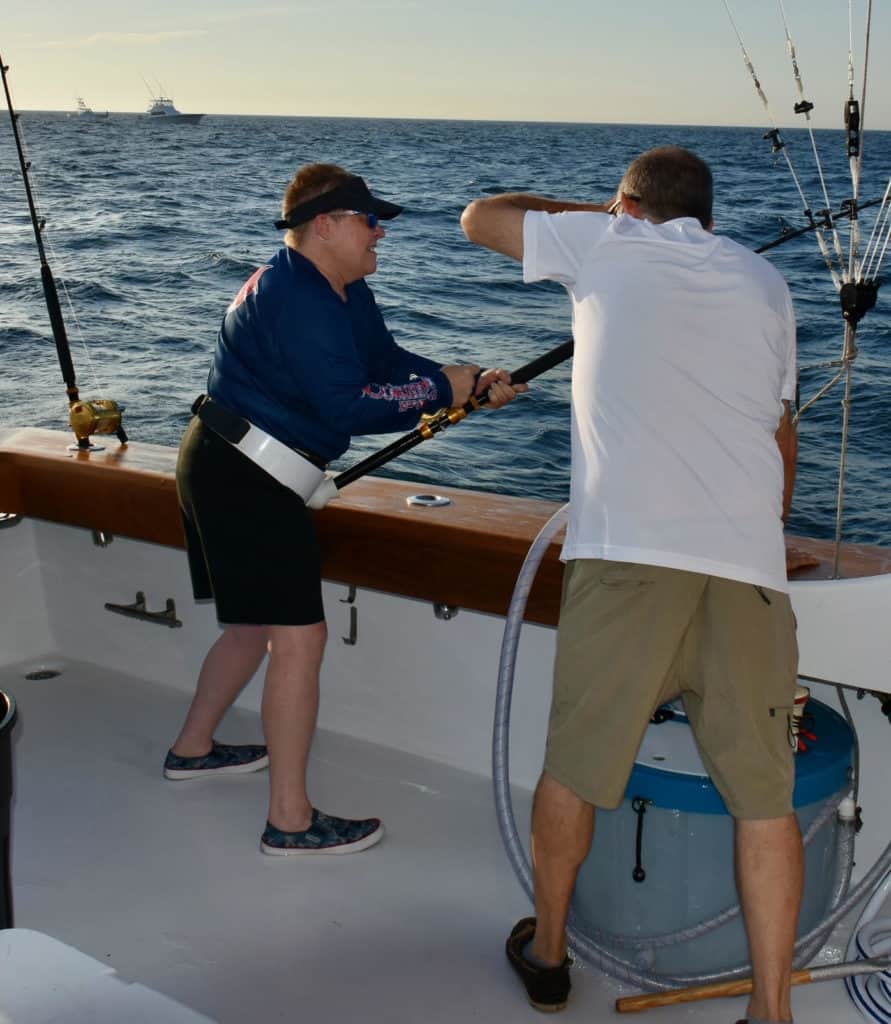Sporting Life

The Tuna Birthday Trip
By Dennis Doyle
The first time an angler ventures offshore out of the sight of land, they get a new understanding of the term blue water. The ocean suddenly assumes an overwhelming shade of deep azure blue and the bottom in the crystal-clear depths seems invisible—it may be a mile or more down. And the fish that swim here are wilder, bigger and more powerful than you can imagine. It’s a truly mesmerizing experience.
My friend, Sam Greene, his aunt, Carol Greene, and her wife, Cherryl Peterson, got a firsthand look at a few of these finned, offshore monsters last week when they chartered the Reel Chaos out of Ocean City, a 62′ Guthrie sportfisher with Captain Anthony Matarese and mate Jake Graves. The event was a celebration of Cherryl’s birthday.
The yellowfin tuna bite has been on fire this year and is populated by some particularly big fish of this species. Yellowfin (also known as ahi) are a thick, fast and muscular fish capable of long powerful runs, amplified by their ability to dive deep. A pelagic (surface dwelling) species, they are migratory along the Atlantic Coast, growing to 200 pounds or more, and found holding well offshore of Ocean City these last two months.
It’s been a while since I’ve tangled with one but I distinctly remember being decidedly on the ropes from just a 40-pounder that refused to come to the boat. Once they get their broad side to you and begin to circle, it’s like having to perform continuous chin-ups for a half hour or so. Not for the faint of heart, nor weak of limb, but they are an exciting and delicious fish.
On this particular charter, the problem the crew faced was caused by the yellowfin’s excellent eyesight. Using chunked butterfish to draw the fish up toward the boat and as bait, the crafty ruffians would shun a bait on anything with over a 25-pound leader. You can’t bring a sizeable tuna to the boat in a reasonable time with that light of a leader. Fifty-pound test is a minimum to put the kind of pressure on a yellowfin needed to bring it to gaff.
Luckily the captain had brought a supply of live Norfolk spot along on the trip, rigging a fishing kite setup that allowed the live baits to swim downwind of the boat, splashing just inches below the surface. The tasty and noisy bait eventually attracted the attention of some of the tuna snacking down current on the bits of butterfish thrown over the side.
Since there were only inches of line visible with this presentation, a section of 50- to 80-pound mono remained virtually invisible to the fish.
The birthday girl, Cherryl, was first up and gasped as a 100-pound tuna bulged up under her swimming spot and inhaled it. As soon as her line came tight, the battle was on and it turned into a fierce encounter.
It was a brutal 20 minute-plus struggle and since I was not present, I really have no idea just how she managed to get that critter to the boat. Eventually, though, the fish yielded and slid into the fish box with the help of the strong arm of Jake the mate. Mike was next up and soon hooked up with that tuna’s twin but lost it at the gaff after a half-hour of struggle. A big disappointment.
Carol manned the camera for the last round as Cherryl, again drawing the lucky rod, fought and landed a 42-pounder and then the bite died and the group reluctantly headed for home. There were few discussions about how best to prepare the tuna for dinner with most opting for a quick browning over charcoal followed by just gobbling down the medium rare fillets with some lemon butter sauce. It was a very happy birthday.
Fishfinder:
Rockfish season reopens August 1, but prospects are mixed. Since few boats were on the water the last two weeks the location of any good school of rockfish is unknown. What is known is that bottlenose dolphin may have chased the bulk of the fish further north past Rock Hall. Time will tell, but blue cats, channel cats and white perch are available throughout the Bay and pleasing anglers. The one bright note this season is the presence of spotted seatrout south around the Honga River. They are taking topwater and soft plastic paddle tails and are in good number. A few years ago, DNR instituted limits that encourage a more robust population to improve the sport fishery, plus limiting commercial exploitation.
In the meantime, crabbing is still distinctly mediocre at best. Half baskets are now the goal as the tasty critters have become very elusive. Things may get better but the juvenile numbers do not suggest it.
